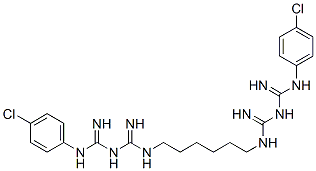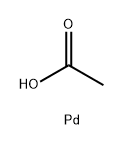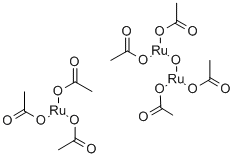Chlorhexidine diacetate salt hydrate , 98% , 56-95-1
Synonym(s):
Chlorhexidine diacetate;Chlorhexidine diacetate salt
CAS NO.:56-95-1
Empirical Formula: C26H38Cl2N10O4
Molecular Weight: 625.55
MDL number: MFCD00012532
EINECS: 200-302-4
| Pack Size | Price | Stock | Quantity |
| 5G | RMB23.20 | In Stock |
|
| 25G | RMB36.80 | In Stock |
|
| 100G | RMB125.60 | In Stock |
|
| 500G | RMB489.60 | In Stock |
|
| others | Enquire |
PRODUCT Properties
| Melting point: | 153-156°C |
| storage temp. | 2-8°C |
| solubility | H2O: 15 mg/mL, clear |
| form | Solid |
| color | White to Almost white |
| Water Solubility | 1.9 g/100 mL (20 ºC) |
| Merck | 14,2091 |
| InChIKey | GHXZTYHSJHQHIJ-UHFFFAOYSA-N |
| LogP | 4.931 (est) |
| CAS DataBase Reference | 56-95-1(CAS DataBase Reference) |
| EPA Substance Registry System | Chlorhexidine diacetate (56-95-1) |
Description and Uses
Chlorhexidine Diacetate is a disinfectant and topical anti-infective agent used also as mouthwash to prevent oral plaque. Chlorhexidine is a cationic broad-spectrum antimicrobial agent belonging to the bis(biguanide) family. Its mechanism of action involves destabilization of the outer bacterial membrane. It is effective on both Gram-positive and Gram-negative bacteria, although it is less effective with some Gram-negative bacteria. It has both bactericidal and bacteriostatic mechanisms of action. Aqueous solutions of chlorhexidine are most stable within the pH range of 5-8. Above pH 8.0 chlorhexidine base is precipitated and in more acid conditions there is gradual deterioration of activity because the compound is less stable. Chlorhexidine is used primarily as a topical antiseptic/disinfectant in wound healing, at catheterization sites, in various dental applications and in surgical scrubs.
Safety
| Symbol(GHS) |    GHS07,GHS08,GHS09 |
| Signal word | Warning |
| Hazard statements | H302-H315-H319-H371-H410 |
| Precautionary statements | P260-P273-P301+P312-P302+P352-P305+P351+P338-P308+P311 |
| Hazard Codes | Xn,Xi,N |
| Risk Statements | 22-43-36/37/38-50/53 |
| Safety Statements | 36/37-36-26-61-60 |
| RIDADR | UN 3077 9 / PGIII |
| WGK Germany | 3 |
| RTECS | DU1930000 |
| F | 8-10 |
| HazardClass | 9 |
| PackingGroup | III |
| HS Code | 2925294500 |
| Toxicity | LD50 orally in mice: 2 g/kg (Davies) |



